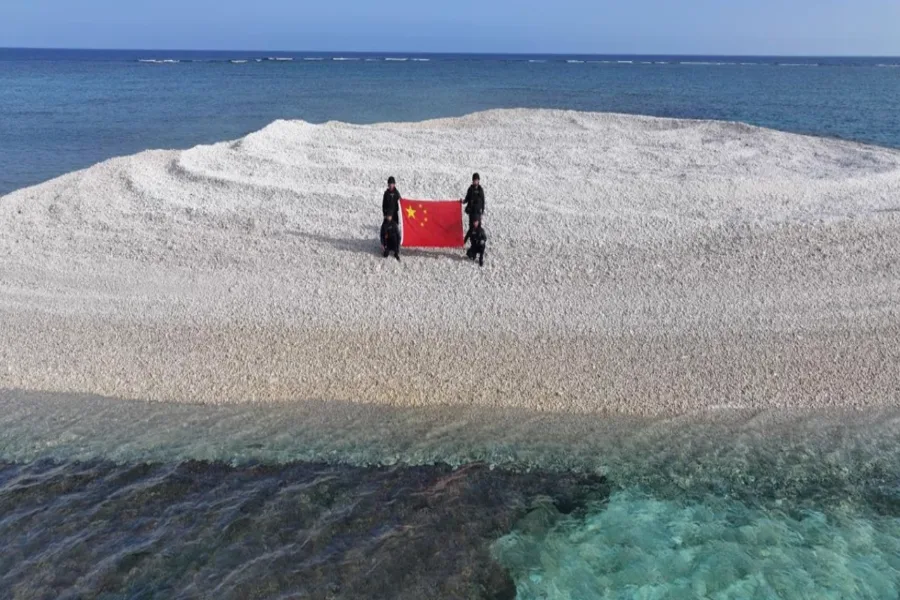Tensions in the South China Sea have been escalating once again due to China’s recent actions on Sandy Cay, a small yet strategically significant rock in the Spratly Islands. This move comes amid growing concerns over violations of territorial sovereignty, international law, and the potential for increased military conflicts. Understanding the legal, geopolitical, and security implications of the disputes surrounding Sandy Cay in the South China Sea is crucial to understanding the region’s dynamics.
What Happened at Sandy Cay?
In early 2025, reports emerged that China had installed markers on Sandy Cay and claimed ownership of this small rock, which is just a few nautical miles from Thitu Island, which is under Philippine control. This action coincided with the Balikatan 2025 military exercises, the largest joint military drills between the U.S. and the Philippines, raising international concerns.
While Sandy Cay may seem insignificant in size, its strategic importance cannot be overlooked. The rock sits in a crucial maritime passage, and control over it would enable China to extend its dominance in the surrounding waters and shipping lanes.
Why is Sandy Cay Important?
- Geopolitical Location: Sandy Cay is located near vital international shipping routes.
- Military Strategy: Control over the rock would give China more leverage in the South China Sea.
- Symbolic Value: Occupying Sandy Cay reinforces China’s territorial claims.
Therefore, China’s occupation of Sandy Cay is not just symbolic; it has real-world legal and strategic consequences.
Legal Implications of China’s Actions
Under International Law:
- According to the United Nations Convention on the Law of the Sea (UNCLOS), the Philippines has exclusive rights in its Exclusive Economic Zone (EEZ), which extends 200 nautical miles from its coastline.
- The Permanent Court of Arbitration (PCA) ruled in 2016 that China’s “nine-dash line” has no legal basis and reaffirmed the Philippines’ maritime rights.
China’s Response:
- China has continuously rejected the PCA ruling and claims “historical rights” over the South China Sea.
- Beijing justifies actions such as the occupation of Sandy Cay as a response to perceived threats, particularly from U.S.-Philippine military activities.
Conclusion:
- Legally, China’s occupation of Sandy Cay is unlawful and violates UNCLOS and the PCA ruling.
- The Philippines retains legal ownership of Sandy Cay under international law.
Global Reactions
Philippines
- Strong diplomatic protests against China.
- Increased military deployments in the region.
United States
- Condemnation of China’s “illegal occupation” of Sandy Cay.
- Emphasis on the U.S.-Philippines mutual defense treaty.
Other Allies
- Japan, Australia, and the UK have urged China to respect international law.
- ASEAN countries have expressed concerns about rising tensions.
Strategic Risks Ahead
- Increased Militarization: China’s control over Sandy Cay could lead to the establishment of new military bases.
- Regional Instability: The risk of military clashes between Chinese and U.S. forces increases.
- Disruptions in Global Trade: Maritime routes could be jeopardized if tensions escalate.
- Weakening of the Rules-Based Order: Undermining international legal frameworks like UNCLOS.
Sandy Cay is poised to become a flashpoint in the South China Sea dispute.
Comparing Sandy Cay to Other Maritime Disputes
- Similar to China’s activities in the Paracel Islands and Scarborough Shoal.
- Reflects a broader pattern of China’s “grey-zone” tactics, where it gradually alters the status quo without overt military conflict.
- Violates the rights of smaller nations and weakens global norms.
Legal Overview
UNCLOS and State Obligations:
- Countries are obligated to respect the EEZ rights of others.
- Artificial islands or installations on low-tide elevations like Sandy Cay do not generate territorial waters under UNCLOS.
Violation of Sovereignty:
- China’s actions are a serious violation of the Philippines’ rights.
- This may trigger obligations under defense treaties, such as the U.S.-Philippines Mutual Defense Treaty.
Future Scenarios
Diplomacy
- ASEAN could play a more significant role in mediating to de-escalate tensions.
- The Philippines may seek further legal support from the international community.
Military Conflict
- The risk of military clashes in the region is growing.
- There is an increasing chance of accidental confrontations between Chinese and U.S. forces.
International Pressure
- Freedom of Navigation Operations (FONOPS) by allied navies may prevent further militarization of Sandy Cay.
Conclusion
The dispute over Sandy Cay in the South China Sea represents a complex intersection of legal, geopolitical, and military strategies in one of the world’s most contentious regions. While this small rock may appear insignificant, its legal and strategic weight is immense. China’s actions remain illegitimate under international law and pose a significant threat to the stability of maritime security in the region. Resolving this dispute peacefully and upholding international law is critical for ensuring regional and global security.

